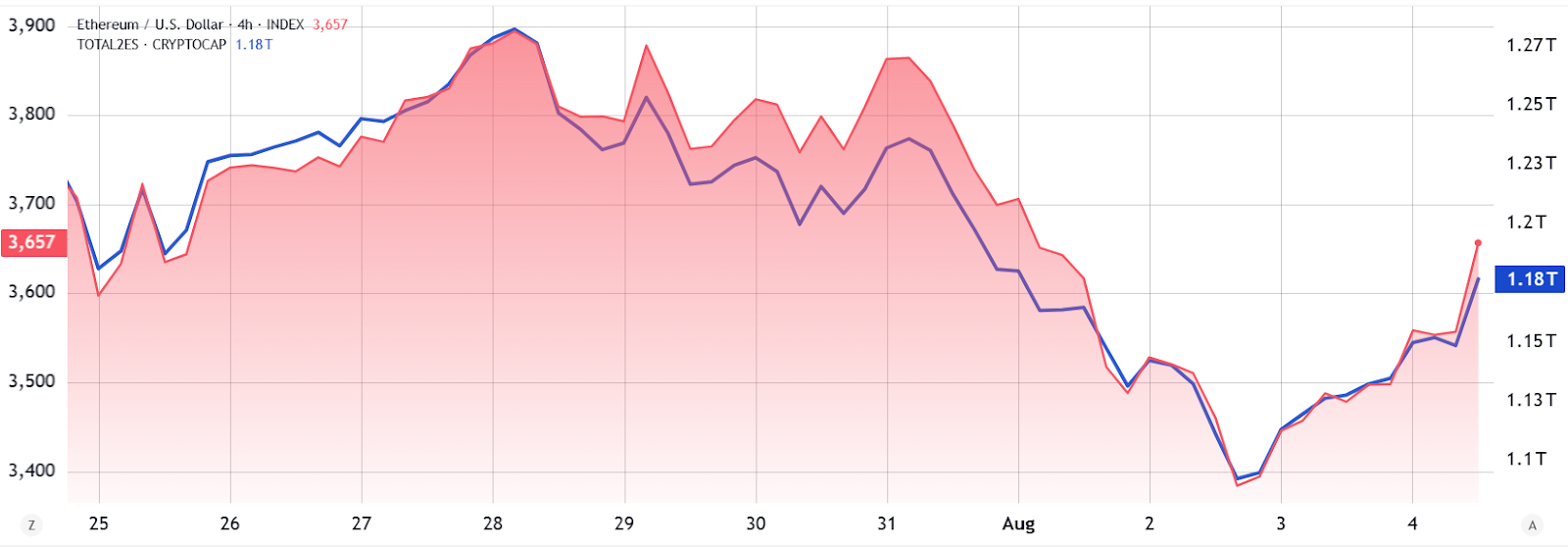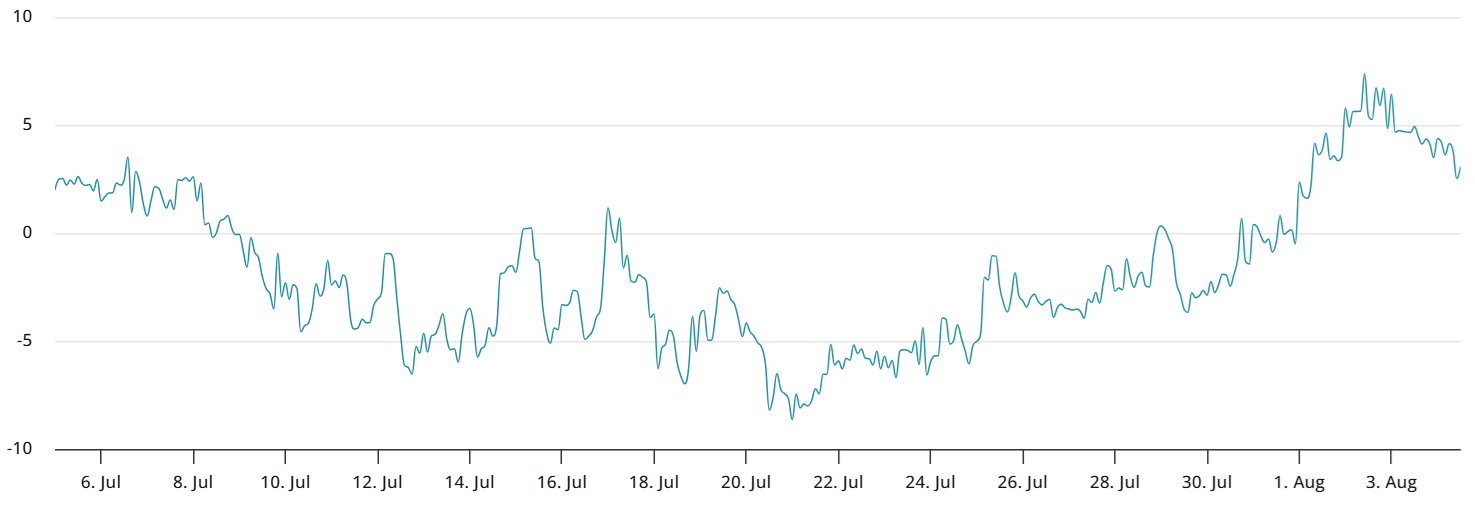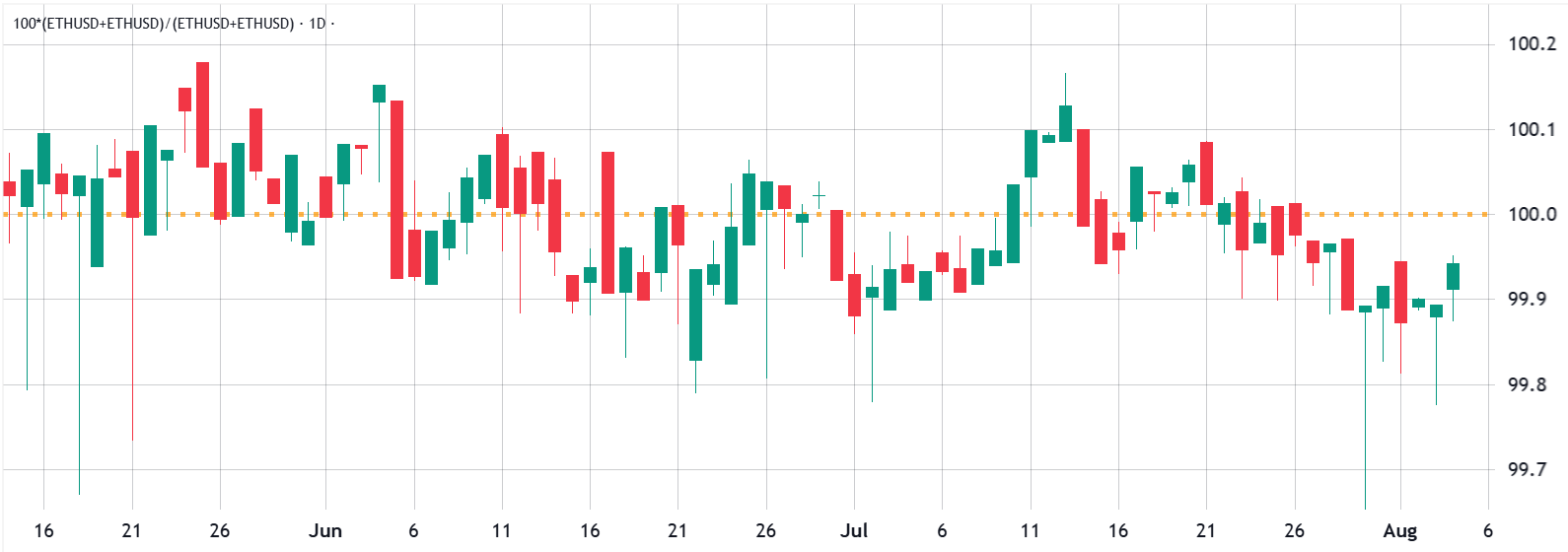Ethereum’s price remains capped below $3,800 due to weak institutional demand and declining total value locked (TVL), closely tracking broader altcoin market trends amid economic uncertainty.
-
Ether’s futures and options data indicate neutral-to-bearish sentiment despite recent price gains.
-
Institutional ETF outflows and lack of catalysts hinder ETH’s breakout above $3,800.
-
Ethereum’s TVL dropped 9% in 30 days, contrasting with gains on BNB Chain and Solana.
Ethereum price struggles with weak institutional demand and declining TVL, limiting gains amid altcoin market uncertainty. Stay informed with COINOTAG’s latest crypto insights.
Why is Ethereum’s Price Struggling to Break $3,800?
Ethereum’s price is constrained by weak institutional demand and a lack of strong market catalysts. Despite a 9% recovery from recent lows, derivatives data reveal cautious trader sentiment. The price movement closely mirrors the overall altcoin market cap, which recently peaked at $1.3 trillion but failed to sustain momentum. This suggests investor risk appetite remains subdued amid ongoing economic concerns.
How Does Ethereum’s Declining TVL Affect Investor Confidence?
The total value locked (TVL) on Ethereum has fallen by 9% over the past month to 23.8 million ETH, signaling reduced activity in decentralized applications (DApps). In contrast, competing networks like BNB Chain and Solana have seen TVL increases of 8% and 4%, respectively. Although Ethereum still holds a dominant 59% share of total TVL in USD terms, the decline reflects waning investor enthusiasm and contributes to cautious market sentiment.

ETH/USD (left, pink) vs. Total altcoin market cap/USD (right, blue). Source: TradingView / Cointelegraph
What Do Futures and Options Data Reveal About Ethereum’s Market Sentiment?
Ether’s 3-month futures premium stands at 5%, indicating a neutral-to-bearish outlook despite recent price levels around $3,900. Additionally, the 25% delta skew in ETH options reached 6%, reflecting increased demand for protective put options. These indicators suggest traders remain cautious, with no clear bullish momentum returning to the market.

Ether 3-month futures annualized premium. Source: laevitas.ch

ETH 30-day options skew (put-call) at Deribit. Source: laevitas.ch
How Does Institutional Demand Impact Ethereum’s Price Movement?
Institutional interest in Ethereum has weakened, as evidenced by ETH trading at a discount on Coinbase and Kraken compared to Binance and Bitfinex. This contrasts with mid-July when premiums suggested capital raising for ETH accumulation. Moreover, Ether spot ETFs experienced $129 million in net outflows recently, further dampening price momentum. Without renewed institutional inflows, ETH is unlikely to decouple from the broader cryptocurrency market.

Coinbase & Kraken ETH/USD premium vs. Binance & Bitfinex. Source: Tradingview / Cointelegraph
What Economic Factors Are Influencing Ethereum’s Market Outlook?
Persistent global trade tensions and concerns about the US job market outlook contribute to investor caution. Economic data may be temporarily inflated by preemptive stockpiling ahead of tariff hikes, leading traders to question the sustainability of growth and inflation figures. This macroeconomic uncertainty limits enthusiasm for risk assets like Ethereum and altcoins.
| Metric | Current Value | Comparison |
|---|---|---|
| Ethereum TVL (30 days) | 23.8 million ETH | ↓ 9% |
| BNB Chain TVL (30 days) | 6.94 billion BNB | ↑ 8% |
| Solana TVL (30 days) | 69.2 million SOL | ↑ 4% |
Frequently Asked Questions
What factors are limiting Ethereum’s price growth in 2025?
Ethereum’s price growth is limited by weak institutional demand, a 9% drop in TVL, and cautious sentiment in futures and options markets, reflecting broader economic uncertainty.
How does institutional ETF outflow impact Ethereum?
Recent $129 million ETF outflows reduce institutional capital inflows, weakening price momentum and preventing ETH from breaking key resistance levels.
Key Takeaways
- Neutral-to-bearish derivatives data: Futures and options metrics indicate cautious trader sentiment despite recent price gains.
- Declining Ethereum TVL: A 9% drop in total value locked contrasts with growth on other blockchains, signaling reduced DApp activity.
- Weak institutional demand: ETF outflows and price discounts on major exchanges reflect diminished institutional interest.
Conclusion
Ethereum’s price remains tethered to broader altcoin market trends due to weak institutional demand and declining TVL. Without new catalysts or renewed capital inflows, ETH is unlikely to surpass the $3,800 resistance in the near term. Investors should monitor derivatives data, institutional flows, and macroeconomic developments to gauge future momentum.
-
Ethereum’s price recovery is limited by weak institutional demand and declining decentralized application activity, highlighting key market challenges.
-
Futures and options data reveal cautious trader sentiment, reflecting uncertainty in the broader altcoin market.
-
COINOTAG analysis shows Ethereum’s TVL decline and ETF outflows as critical factors restraining price growth.
Ethereum price capped below $3,800 amid weak institutional demand and TVL decline. Get the latest crypto market insights from COINOTAG.
Ethereum Price Mirrors Altcoin Market Trends Amid Weak Catalysts
Ethereum’s price action has closely tracked the broader altcoin market capitalization, which peaked at $1.3 trillion on July 28. Despite a 9% gain from recent lows, ETH failed to break above $3,800, reflecting a lack of strong catalysts. Investor risk appetite remains cautious amid economic uncertainty, limiting sustained bullish momentum.
Declining TVL Dampens Ethereum Investor Sentiment
Ethereum’s total value locked (TVL) dropped 9% to 23.8 million ETH over 30 days, signaling reduced activity in decentralized applications. In contrast, BNB Chain and Solana saw TVL increases of 8% and 4%, respectively. This decline weighs on investor confidence despite Ethereum’s dominant 59% share of total TVL in USD terms.

ETH/USD (left, pink) vs. Total altcoin market cap/USD (right, blue). Source: TradingView / Cointelegraph
Futures and Options Data Indicate Neutral-to-Bearish Outlook
Ether’s 3-month futures premium stands at 5%, marking a neutral-to-bearish threshold even after price reached $3,900. The 25% delta skew in options markets rose to 6%, showing increased demand for protective puts. These indicators highlight cautious trader sentiment and a lack of bullish conviction.

Ether 3-month futures annualized premium. Source: laevitas.ch

ETH 30-day options skew (put-call) at Deribit. Source: laevitas.ch
Institutional Demand Weakness Limits ETH Price Breakout
ETH trading at a discount on Coinbase and Kraken compared to Binance and Bitfinex suggests weaker institutional demand. Recent $129 million ETF outflows further dampen momentum. Without renewed capital inflows, ETH is unlikely to decouple from the broader cryptocurrency market.

Coinbase & Kraken ETH/USD premium vs. Binance & Bitfinex. Source: Tradingview / Cointelegraph
Macroeconomic Risks Weigh on Ethereum and Altcoins
Ongoing global trade tensions and concerns over the US labor market contribute to cautious investor sentiment. Economic data may be temporarily inflated by stockpiling ahead of tariffs, increasing uncertainty about sustainable growth. These factors limit enthusiasm for risk assets like Ethereum.
